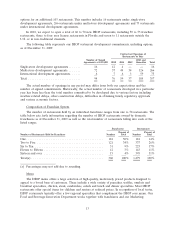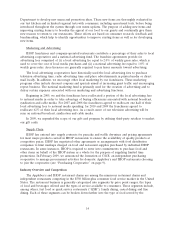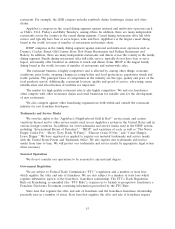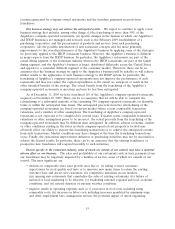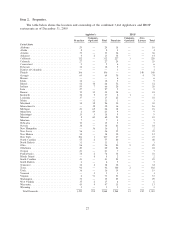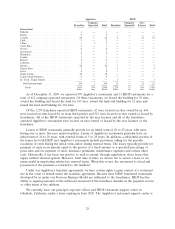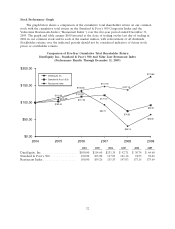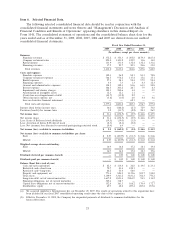IHOP 2009 Annual Report Download - page 42
Download and view the complete annual report
Please find page 42 of the 2009 IHOP annual report below. You can navigate through the pages in the report by either clicking on the pages listed below, or by using the keyword search tool below to find specific information within the annual report.• delays in obtaining construction permits and in completion of construction;
• developed properties not achieving desired revenue or cash flow levels once opened;
• competition for suitable development sites;
• changes in governmental rules, regulations, and interpretations (including interpretations of the
requirements of the ADA); and
• general economic and business conditions.
We cannot assure that the development and construction of facilities will be completed, or that any
such development will be completed in a timely manner. We cannot assure that present or future
development will perform in accordance with our expectations.
The opening and success of Applebee’s and IHOP restaurants depend on various factors, including
the demand for Applebee’s and IHOP restaurants and the selection of appropriate franchisee
candidates, the availability of suitable sites, the negotiation of acceptable lease or purchase terms for
new locations, costs of construction, permit issuance and regulatory compliance, the ability to meet
construction schedules, the availability of financing and other capabilities of franchisees. There is no
assurance that franchisees planning the opening of restaurants will have the business abilities or
sufficient access to financial resources necessary to open the restaurants required by their agreements.
It cannot be assured that franchisees will successfully participate in our strategic initiatives or operate
their restaurants in a manner consistent with our concept and standards.
Concentration of Applebee’s franchised restaurants in a limited number of franchisees subjects us to
greater credit risk. As of December 31, 2009, Applebee’s franchisees operated 1,470 Applebee’s
restaurants in the United States, which restaurants comprised 79% of the total Applebee’s restaurants
in the United States. As of December 31, 2009, the nine largest Applebee’s franchisees owned 786
restaurants, representing 53% of all franchised Applebee’s restaurants in the United States. The
concentration of franchised restaurants in a limited number of franchisees subjects us to a potentially
higher level of credit risk in respect of such franchisees because their financial obligations to us are
greater as compared to those franchisees with fewer restaurants. The risk associated with these
franchisees is also greater where franchisees are the sole or dominant franchisee for a particular region
of the United States, as is the case for most domestic Applebee’s franchised territories. In particular, if
any of these franchisees experiences financial or other difficulties, the franchisee may default on its
obligations under multiple franchise agreements including payments to us and the maintenance and
improvement of its restaurants. If any of these franchisees are subject to bankruptcy or insolvency
proceedings, a bankruptcy court may prevent the termination of the related franchise agreements and
development Agreements. Any franchisee that is experiencing financial difficulties may also be unable
to participate in implementing changes to our business strategy. Any franchisee that owns and operates
a significant number of Applebee’s restaurants and fails to comply with its other obligations under the
franchise agreement, such as those relating to the quality and preparation of food and maintenance of
restaurants, could cause significant harm to the Applebee’s brand and subject us to claims by
consumers even if we are not legally liable for the franchisee’s actions or failure to act. The franchising
of most the company-operated Applebee’s restaurants that is part of our strategy is not expected to
reduce the degrees of concentration of franchised Applebee’s restaurants because the existing
franchisees are the likely candidates to acquire company-operated restaurants. The concentration of the
franchised Applebee’s restaurants in a limited number of franchisees may also reduce our negotiating
power with respect to the terms of sale of the company-operated Applebee’s restaurants. Development
rights for Applebee’s restaurants are also concentrated among a limited number of existing franchisees.
If any of these existing franchisees experience financial difficulties, future development of Applebee’s
restaurant may be materially adversely affected.
23


